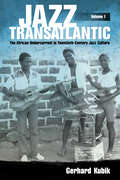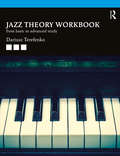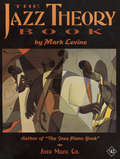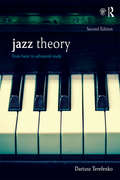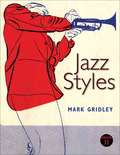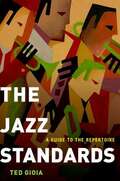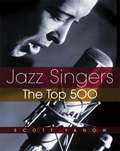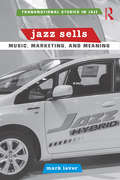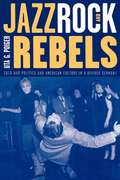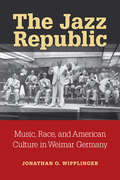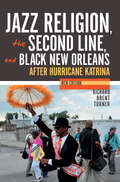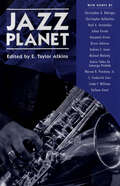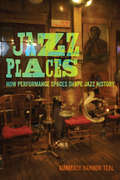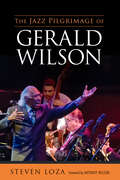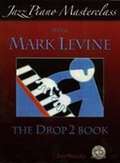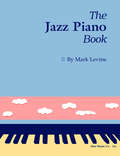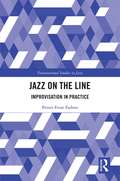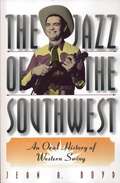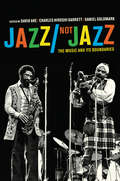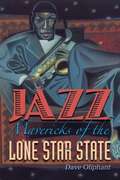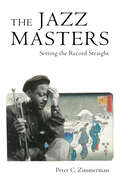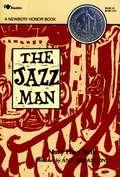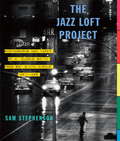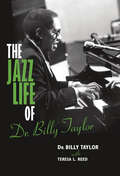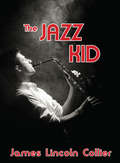- Table View
- List View
Jazz Transatlantic, Volume I: The African Undercurrent in Twentieth-Century Jazz Culture (American Made Music Series)
by Gerhard KubikA CHOICE 2018 Outstanding Academic TitleIn Jazz Transatlantic, Volume I, renowned scholar Gerhard Kubik takes the reader across the Atlantic from Africa to the Americas and then back in pursuit of the music we call jazz. This first volume explores the term itself and how jazz has been defined and redefined. It also celebrates the phenomena of jazz performance and uncovers hidden gems of jazz history. The volume offers insights gathered during Kubik's extensive field work and based on in-depth interviews with jazz musicians around the Atlantic world. Languages, world views, beliefs, experiences, attitudes, and commodities all play a role. Kubik reveals what is most important--the expertise of individual musical innovators on both sides of the Atlantic, and hidden relationships in their thoughts.Besides the common African origins of much vocabulary and structure, all the expressions of jazz in Africa share transatlantic family relationships. Within that framework, musicians are creating and re-creating jazz in never-ending contacts and exchanges. The first of two volumes, Jazz Transatlantic, Volume I examines this transatlantic history, sociolinguistics, musicology, and the biographical study of personalities in jazz during the twentieth century. This volume traces the African and African American influences on the creation of the jazz sound and traces specific African traditions as they transform into American jazz. Kubik seeks to describe the constant mixing of sources and traditions, so he includes influences of European music in both volumes. These works will become essential and indelible parts of jazz history.
Jazz Theory Workbook: From Basic to Advanced Study
by Dariusz TerefenkoJazz Theory Workbook accompanies the second edition of the successful Jazz Theory—From Basic to Advanced Study textbook designed for undergraduate and graduate students studying jazz. The overall pedagogy bridges theory and practice, combining theory, aural skills, keyboard skills, and improvisation into a comprehensive whole. While the Companion Website for the textbook features aural and play-along exercises, along with some written exercises and the answer key, this workbook contains brand-new written exercises, as well as as well as four appendices: (1) Rhythmic Exercises, (2) Common-Practice Harmony at the Keyboard, (3) Jazz Harmony at the Keyboard, and (4) Patterns for Jazz Improvisaton. Jazz Theory Workbook works in tandem with its associated textbook in the same format as the 27-chapter book, yet is also designed to be used on its own, providing students and readers with quick access to all relevant exercises without the need to download or print pages that inevitably must be written out. The workbook is sold both on its own as well as discounted in a package with the textbook. Jazz Theory Workbook particularly serves the ever-increasing population of classical students interested in jazz theory or improvisation. This WORKBOOK is available for individual sale in various formats: Print Paperback: 9781138334250 Print Hardback: 9781138334243 eBook: 9780429445477 The paperback WORKBOOK is also paired with the corresponding paperback TEXTBOOK in a discounted PACKAGE (9780367321963).
The Jazz Theory Book
by Sher Music Mark LevineThe most highly-acclaimed jazz theory book ever published! Over 500 pages of comprehensive, but easy to understand text covering every aspect of how jazz is constructed---chord construction, II-V-I progressions, scale theory, chord/scale relationships, the blues, reharmonization, and much more. A required text in universities world-wide, translated into five languages, endorsed by Jamey Aebersold, James Moody, Dave Liebman, etc.
Jazz Theory: From Basic to Advanced Study
by Dariusz TerefenkoJazz Theory: From Basic to Advanced Study, Second Edition, is a comprehensive textbook for those with no previous study in jazz, as well as those in advanced theory courses. Written with the goal to bridge theory and practice, it provides a strong theoretical foundation from music fundamentals to post-tonal theory, while integrating ear training, keyboard skills, and improvisation. It hosts "play-along" audio tracks on a Companion Website, including a workbook, ear-training exercises, and an audio compilation of the musical examples featured in the book. Jazz Theory is organized into three parts: Basics, Intermediate, and Advanced. This approach allows for success in a one-semester curriculum or with subsequent terms. If students sense that theory can facilitate their improvisational skills or can help them develop their ears, they become more engaged in the learning process. The overall pedagogical structure accomplishes precisely that in an original, creative—and above all, musical—manner. KEY FEATURES include 390 musical examples, ranging from original lead sheets of standard tunes, jazz instrumentals, transcriptions, and original compositions, to fully realized harmonic progressions, sample solos, and re-harmonized tunes. The completely revamped Companion Website hosts: 46 "Play Along Sessions" audio tracks, offering experiences close to real-time performance scenarios. Over 1,000 (audio and written) exercises covering ear training, rhythm, notation, analysis, improvisation, composition, functional keyboard, and others. Recordings of all 390 musical examples from the textbook. Links: Guide to Making Transcriptions, List of Solos to Transcribe, Selected Discography, Classification of Standard Tunes, and more. Lists of well-known standard tunes, including a comprehensive list of 999 Standard Tunes – Composers and Lyricists. NEW TO THE SECOND EDITION are instructors’ tools with answer keys to written and ear-training exercises, 380 rhythmic calisthenics featuring exercises from the swing, bebop, and Latin rhythmic traditions, a new improvisation section, a set of 140 Comprehensive Keyboard exercises, plus an expanded ear-training section with 125 melodic, 50 rhythmic dictations, and 170 harmonic dictations, plus 240 written exercises, 25 composition assignments, and 110 singing exercises.
Jazz Styles: History and Analysis
by Mark C. GridleyThis book was written to help listeners increase their appreciation and enjoyment of jazz. The book and its accompanying Demo CD give readers a peek into how jazz musicians put together performances and how their methods have differed from style to style.
The Jazz Standards: A Guide to the Repertoire
by Ted GioiaTHE JAZZ STANDARDS, a comprehensive guide to the most important jazz compositions, is a unique resource, a browser's companion, and an invaluable introduction to the art form. This essential book for music lovers tells the story of 252 key jazz songs and includes a listening guide to more than 2,000 recordings. Many books recommend jazz CDs or discuss musicians and styles, but this is the first to tell the story of the songs themselves. The fan who wants to know more about a jazz song heard at the club or on the radio will find this book indispensable. Musicians who play these songs night after night now have a handy guide, outlining their history and significance and telling how they have been performed by different generations of jazz artists. Students learning about jazz standards now have a complete reference work for all of these cornerstones of the repertoire. Author Ted Gioia, whose body of work includes the award-winning The History of Jazz and Delta Blues, is the perfect guide to lead readers through the classics of the genre. As a jazz pianist and recording artist, he has performed these songs for decades. As a music historian and critic, he has gained a reputation as a leading expert on jazz. Here he draws on his deep experience with this music in creating the ultimate work on the subject. An introduction for new fans, a useful handbook for jazz enthusiasts and performers, and an important reference for students and educators, The Jazz Standards belongs on the shelf of every serious jazz lover or musician. After each song is discussed, the author lists several recommended recordings in chronological order. TED GIOIA is a musician, author, jazz critic, and leading expert on American music. His previous books The History of Jazz and Delta Blues were both selected as notable books of the year in the New York Times. He is also the author of West Coast Jazz, Work Songs, Healing Songs, and The Birth (and Death) of the Cool. The DAISY edition contains a mark for each song at level 1.
The Jazz Singers: The Ultimate Guide
by Scott Yanow"The Jazz Singers: The Ultimate Guide is an overview of jazz vocalism. This guide consists of more than 800 profiles that together span the history of jazz, from the dawn of commercial recordings to the present day. Author Scott Yanow goes beyond the household names to include many other important singers of yesterday and today."--BOOK JACKET.
Jazz Sells: Music, Marketing, and Meaning
by Mark LaverJazz Sells: Music, Marketing, and Meaning examines the issues of jazz, consumption, and capitalism through advertising. On television, on the Internet, in radio, and in print, advertising is a critically important medium for the mass dissemination of music and musical meaning. This book is a study of the use of the jazz genre as a musical signifier in promotional efforts, exploring how the relationship between brand, jazz music, and jazz discourses come together to create meaning for the product and the consumer. At the same time, it examines how jazz offers an invaluable lens through which to examine the complex and often contradictory culture of consumption upon which capitalism is predicated.
Jazz, Rock, and Rebels
by Uta G. PoigerIn the two decades after World War II, Germans on both sides of the iron curtain fought vehemently over American cultural imports. Uta G. Poiger traces how westerns, jeans, jazz, rock 'n' roll, and stars like Marlon Brando or Elvis Presley reached adolescents in both Germanies, who eagerly adopted the new styles. Poiger reveals that East and West German authorities deployed gender and racial norms to contain Americanized youth cultures in their own territories and to carry on the ideological Cold War battle with each other. Poiger's lively account is based on an impressive array of sources, ranging from films, newspapers, and contemporary sociological studies, to German and U.S. archival materials. Jazz, Rock, and Rebels examines diverging responses to American culture in East and West Germany by linking these to changes in social science research, political cultures, state institutions, and international alliance systems. In the first two decades of the Cold War, consumer culture became a way to delineate the boundaries between East and West. This pathbreaking study, the first comparative cultural history of the two Germanies, sheds new light on the legacy of Weimar and National Socialism, on gender and race relations in Europe, and on Americanization and the Cold War.
The Jazz Republic: Music, Race, and American Culture in Weimar Germany
by Jonathan O. WipplingerThe Jazz Republic examines jazz music and the jazz artists who shaped Germany’s exposure to this African American art form from 1919 through 1933. Jonathan O. Wipplinger explores the history of jazz in Germany as well as the roles that music, race (especially Blackness), and America played in German culture and follows the debate over jazz through the fourteen years of Germany’s first democracy. He explores visiting jazz musicians including the African American Sam Wooding and the white American Paul Whiteman and how their performances were received by German critics and artists. The Jazz Republic also engages with the meaning of jazz in debates over changing gender norms and jazz’s status between paradigms of high and low culture. By looking at German translations of Langston Hughes’s poetry, as well as Theodor W. Adorno’s controversial rejection of jazz in light of racial persecution, Wipplinger examines how jazz came to be part of German cultural production more broadly in both the US and Germany, in the early 1930s. Using a wide array of sources from newspapers, modernist and popular journals, as well as items from the music press, this work intervenes in the debate over the German encounter with jazz by arguing that the music was no mere “symbol” of Weimar’s modernism and modernity. Rather than reflecting intra-German and/or European debates, it suggests that jazz and its practitioners, African American, white American, Afro-European, German and otherwise, shaped Weimar culture in a central way.
Jazz Religion, the Second Line, and Black New Orleans, New Edition: After Hurricane Katrina
by Richard Brent TurnerAn examination of the musical, religious, and political landscape of black New Orleans before and after Hurricane Katrina, this revised edition looks at how these factors play out in a new millennium of global apartheid. Richard Brent Turner explores the history and contemporary significance of second lines--the group of dancers who follow the first procession of church and club members, brass bands, and grand marshals in black New Orleans's jazz street parades. Here music and religion interplay, and Turner's study reveals how these identities and traditions from Haiti and West and Central Africa are reinterpreted. He also describes how second line participants create their own social space and become proficient in the arts of political disguise, resistance, and performance.
Jazz Planet
by E. Taylor AtkinsWith contributions by Raúl A. Fernández, Benjamin Givan, Acácio Tadeu de Camargo Piedade, Warren R. Pinckney Jr., Linda F. Williams, Christopher G. Bakriges, Stefano Zenni, S. Frederick Starr, Bruce Johnson, Christophine Ballantine, Michael Molasky, Johan Fornäs, and Andrew F. JonesJazz is typically characterized as a uniquely American form of artistic expression, and narratives of its history are almost always set within the United States. Yet, from its inception, this art form exploded beyond national borders, becoming one of the first modern examples of a global music sensation. Jazz Planet collects essays that concentrate for the first time on jazz created outside the United States. What happened when this phenomenon met with indigenous musical practices? What debates on cultural integrity did this “American” styling provoke in far-flung places? Did jazz's insistence on individual innovation and its posture as a music of the disadvantaged generate shakeups in national identity, aesthetic values, and public morality? Through new and previously published essays, Jazz Planet recounts the music's fascinating journeys to Asia, Europe, Africa, and Latin America. What emerges is a concept of jazz as a harbinger of current globalization, a process that has engendered both hope for a more enlightened and tranquil future and resistance to the anticipated loss of national identity and sovereignty. Essays in this collection describe the seldom-acknowledged contributions non-Americans have made to the art and explore the social and ideological crises jazz initiated around the globe. Was the rise of jazz in global prominence, they ask, simply a result of its inherent charm? Was it a vehicle for colonialism, Cold War politics, and emerging American hegemony? Jazz Planet provokes readers to question the nationalistic bias of most jazz scholarship, and to expand the pantheon of great jazz artists to include innovative musicians who blazed independent paths.
Jazz Places: How Performance Spaces Shape Jazz History
by Kimberly Hannon TealThe social connotation of jazz in American popular culture has shifted dramatically since its emergence in the early twentieth century. Once considered youthful and even rebellious, jazz music is now a firmly established American artistic tradition. As jazz in American life has shifted, so too has the kind of venue in which it is performed. In Jazz Places, Kimberly Hannon Teal traces the history of jazz performance from private jazz clubs to public, high-art venues often associated with charitable institutions. As live jazz performance has become more closely tied to nonprofit institutions, the music's heritage has become increasingly important, serving as a means of defining jazz as a social good worthy of charitable support. Though different jazz spaces present jazz and its heritage in various and sometimes conflicting terms, ties between the music and the past play an important role in defining the value of present-day music in a diverse range of jazz venues, from the Village Vanguard in New York to SFJazz on the West Coast to Preservation Hall in New Orleans.
The Jazz Pilgrimage of Gerald Wilson (American Made Music Series)
by Steven LozaJazz great Gerald Wilson (1918-2014), born in Shelby, Mississippi, left a global legacy of paramount significance through his progressive musical ideas and his orchestra's consistent influence on international jazz. Aided greatly by interviews that bring Wilson's voice to the story, Steven Loza presents a perspective on what the musician and composer called his "jazz pilgrimage."Wilson uniquely adapted Latin influences into his jazz palette, incorporating many Cuban and Brazilian inflections as well as those of Mexican and Spanish styling. Throughout the book, Loza refers to Wilson's compositions and arrangements, including their historical contexts and motivations. Loza provides savvy musical readings and analysis of the repertoire. He concludes by reflecting upon Wilson's ideas on the place of jazz culture in America, its place in society and politics, its origins, and its future.With a foreword written by Wilson's son, Anthony, and such sources as essays, record notes, interviews, and Wilson's own reflections, the biography represents the artist's ideas with all their philosophical, historical, and cultural dimensions. Beyond merely documenting Wilson's many awards and recognitions, this book ushers readers into the heart and soul of a jazz creator. Wilson emerges a unique and proud African American artist whose tunes became a mosaic of the world.
Jazz Piano Masterclass with Mark Levine: The Drop 2 Book
by Mark LevineThis book covers both the basic version of the jazz technique called drop 2 and the more advanced version.
The Jazz Piano Book
by Sher Music Mark LevineThe most highly acclaimed jazz piano method ever published! Over 300 pages with complete chapters on Intervals and triads, The major modes and II-V-I, 3-note voicings, Sus. and phrygian Chords, Adding notes to 3-note voicings, Tritone substitution, Left-hand voicings, Altering notes in left-hand Stride and Bud Powell voicings, Block chords, Comping ...and much more! Endorsed by Kenny Barron, Down Beat, Jamey Aebersold, etc.<P> Advisory: Bookshare has learned that this book offers only partial accessibility. We have kept it in the collection because it is useful for some of our members. To explore further access options with us, please contact us through the Book Quality link on the right sidebar. Benetech is actively working on projects to improve accessibility issues such as these.
Jazz on the Line: Improvisation in Practice
by Petter Frost FadnesJazz on the Line: Improvisation in Practice presents an ethnographic reflection on improvisation as performance, examining how musicians think and act when negotiating improvisational frameworks. This multidisciplinary discussion—guided by a focus on recordings, composition, authenticity, and venues—explores the musical choices made by performers, emphasizing how these choices can be logically understood within the context of controlled, musical outputs. Throughout the text, the author engages directly with musicians and their varied practices—from canonized dogmas to innovative experimentalism—offering interviews both planned and spontaneous. Musical agency is posited as a tightrope balancing act, signifying the skill and excitement of improvisational performativity and exemplifying the life of a jazzaerialist. With a travel journal approach as a backdrop, Jazz on the Line provides concepts and theories that demystify the creative processes of improvisation.
The Jazz of the Southwest
by Jean A. BoydThey may wear cowboy hats and boots and sing about "faded love," but western swing musicians have always played jazz! From Bob Wills and the Texas Playboys to Asleep at the Wheel, western swing performers have played swing jazz on traditional country instruments, with all of the required elements of jazz, and some of the best solo improvisation ever heard. In this book, Jean A. Boyd explores the origins and development of western swing as a vibrant current in the mainstream of jazz. She focuses in particular on the performers who made the music, drawing on personal interviews with some fifty living western swing musicians. From pioneers such as Cliff Bruner and Eldon Shamblin to current performers such as Johnny Gimble, the musicians make important connections between the big band swing jazz they heard on the radio and the western swing they created and played across the Southwest from Texas to California. From this first-hand testimony, Boyd re-creates the world of western swing-the dance halls, recording studios, and live radio shows that broadcast the music to an enthusiastic listening audience. Although the performers typically came from the same rural roots that nurtured country music, their words make it clear that they considered themselves neither "hillbillies" nor "country pickers," but jazz musicians whose performance approach and repertory were no different from those of mainstream jazz. This important aspect of the western swing story has never been told before.
Jazz/Not Jazz
by Daniel Goldmark Charles Hiroshi Garrett David AkeWhat is jazz? What is gained--and what is lost--when various communities close ranks around a particular definition of this quintessentially American music? Jazz/Not Jazz explores some of the musicians, concepts, places, and practices which, while deeply connected to established jazz institutions and aesthetics, have rarely appeared in traditional histories of the form. David Ake, Charles Hiroshi Garrett, and Daniel Goldmark have assembled a stellar group of writers to look beyond the canon of acknowledged jazz greats and address some of the big questions facing jazz today.More than just a history of jazz and its performers, this collections seeks out those people and pieces missing from the established narratives to explore what they can tell us about the way jazz has been defined and its history has been told.
Jazz Mavericks of the Lone Star State
by Dave OliphantJazz is one of America's greatest gifts to the arts, and native Texas musicians have played a major role in the development of jazz from its birth in ragtime, blues, and boogie-woogie to its most contemporary manifestation in free jazz. Dave Oliphant began the fascinating story of Texans and jazz in his acclaimed book Texan Jazz, published in 1996. Continuing his riff on this intriguing musical theme, Oliphant uncovers in this new volume more of the prolific connections between Texas musicians and jazz. Jazz Mavericks of the Lone Star State presents sixteen published and previously unpublished essays on Texans and jazz. Oliphant celebrates the contributions of such vital figures as Eddie Durham, Kenny Dorham, Leo Wright, and Ornette Coleman. He also takes a fuller look at Western Swing through Milton Brown and his Musical Brownies and a review of Duncan McLean's Lone Star Swing. In addition, he traces the relationship between British jazz criticism and Texas jazz and defends the reputation of Texas folklorist Alan Lomax as the first biographer of legendary jazz pianist-composer Jelly Roll Morton. In other essays, Oliphant examines the links between jazz and literature, including fiction and poetry by Texas writers, and reveals the seemingly unlikely connection between Texas and Wisconsin in jazz annals. All the essays in this book underscore the important parts played by Texas musicians in jazz history and the significance of Texas to jazz, as also demonstrated by Oliphant's reviews of the Ken Burns PBS series on jazz and Alfred Appel Jr. 's Jazz Modernism.
The Jazz Masters: Setting the Record Straight (American Made Music Series)
by Peter C. ZimmermanThe Jazz Masters: Setting the Record Straight is a celebration of jazz and the men and women who created and transformed it. In the twenty-one conversations contained in this engaging and highly accessible book, we hear from the musicians themselves, in their own words, direct and unfiltered. Peter Zimmerman’s interviewing technique is straightforward. He turns on a recording device, poses questions, and allows his subjects to improvise, similar to the way the musicians do at concerts and in recording sessions. Topics range from their early days, their struggles and victories, to the impact the music has had on their own lives. The interviews have been carefully edited for sense and clarity, without changing any of the musicians’ actual words.Peter Zimmerman tirelessly sought virtuosi whose lives span the twentieth and twenty-first centuries. The reader is rewarded with an intimate look into the past century’s extraordinary period of creative productivity. The oldest two interview subjects were born in 1920 and all are professional musicians who worked in jazz for at least five decades, with a few enjoying careers as long as seventy-five years. These voices reflect some seventeen hundred years of accumulated experience yielding a chronicle of incredible depth and scope.The focus on musicians who are now emeritus figures is deliberate. Some of them are now in their nineties; six have passed since 2012, when Zimmerman began researching The Jazz Masters. Five of them have already received the NEA’s prestigious Jazz Masters award: Sonny Rollins, Clark Terry, Yusef Lateef, Jimmy Owens, and most recently, Dick Hyman. More undoubtedly will one day, and the balance are likewise of compelling interest. Artists such as David Amram, Charles Davis, Clifford Jordan, Valery Ponomarev, and Sandy Stewart, to name a few, open their hearts and memories and reveal who they are as people.This book is a labor of love celebrating the vibrant style of music that Dizzy Gillespie once described as “our native art form.” Zimmerman’s deeply knowledgeable, unabashed passion for jazz brings out the best in the musicians. Filled with personal recollections and detailed accounts of their careers and everyday lives, this highly readable, lively work succeeds in capturing their stories for present and future generations. An important addition to the literature of music, The Jazz Masters goes a long way toward “setting the record straight.”
The Jazz Man
by Mary Hays WeikWhen the Jazz Man played, Zeke thought about nothing else but the wonderful music that drifted from the bright yellow room across the courtyard. He did not think about how his mother crept up and down five long flights of stairs every day to go to work. He did not think about the jobs he knew his father must work. He thought about just of the dreamy blues adding color to his drab world. How long will Zeke's dreams last when the Jazz Man leaves?<P><P> Newbery Medal Honor Book
The Jazz Loft Project
by Sam StephensonIn 1957, Eugene Smith, a thirty-eight-year-old magazine photographer, walked out of his comfortable settled world--his longtime well-paying job at Life and the home he shared with his wife and four children in Croton-on-Hudson, New York--to move into a dilapidated, five-story loft building at 821 Sixth Avenue (between Twenty-eighth and Twenty-ninth streets) in New York City's wholesale flower district. Smith was trying to complete the most ambitious project of his life, a massive photo-essay on the city of Pittsburgh.821 Sixth Avenue was a late-night haunt of musicians, including some of the biggest names in jazz--Charles Mingus, Zoot Sims, Bill Evans, and Thelonious Monk among them--and countless fascinating, underground characters. As his ambitions broke down for his quixotic Pittsburgh opus, Smith found solace in the chaotic, somnambulistic world of the loft and its artists. He turned his documentary impulses away from Pittsburgh and toward his offbeat new surroundings.From 1957 to 1965, Smith exposed 1,447 rolls of film at his loft, making roughly 40,000 pictures, the largest body of work in his career, photographing the nocturnal jazz scene as well as life on the streets of the flower district, as seen from his fourth-floor window. He wired the building like a surreptitious recording studio and made 1,740 reels (4,000 hours) of stereo and mono audiotapes, capturing more than 300 musicians, among them Roy Haynes, Sonny Rollins, Bill Evans, Roland Kirk, Alice Coltrane, Don Cherry, and Paul Bley. He recorded, as well, legends such as pianists Eddie Costa, and Sonny Clark, drummers Ronnie Free and Edgar Bateman, saxophonist Lin Halliday, bassist Henry Grimes, and multi-instrumentalist Eddie Listengart.Also dropping in on the nighttime scene were the likes of Doris Duke, Norman Mailer, Diane Arbus, Robert Frank, Henri Cartier-Bresson, and Salvador Dalí, as well as pimps, prostitutes, drug addicts, thieves, photography students, local cops, building inspectors, marijuana dealers, and others.Sam Stephenson discovered Smith's jazz loft photographs and tapes eleven years ago and has spent the last seven years cataloging, archiving, selecting, and editing Smith's materials for this book, as well as writing its introduction and the text interwoven throughout.W. Eugene Smith's Jazz Loft Project has been legendary in the worlds of art, photography, and music for more than forty years, but until the publication of The Jazz Loft Project, no one had seen Smith's extraordinary photographs or read any of the firsthand accounts of those who were there and lived to tell the tale(s) . . .
The Jazz Life of Dr. Billy Taylor
by Teresa L. ReedLegendary jazz ambassador Dr. Billy Taylor's autobiography spans more than six decades, from the heyday of jazz on 52nd Street in 1940s New York City to CBS Sunday Morning. Taylor fought not only for the recognition of jazz music as "America's classical music" but also for the recognition of black musicians as key contributors to the American music repertoire. Peppered with anecdotes recalling encounters with other jazz legends such as Jelly Roll Morton, Duke Ellington, Art Tatum, Count Basie, Billie Holiday, and many others, The Jazz Life of Dr. Billy Taylor is not only the life story of a jazz musician and spokesman but also a commentary on racism and jazz as a social force.
The Jazz Kid
by James Lincoln CollierPaulie Horvath is never going to be a good student like his brother, John, never going to follow his hardworking father into the plumbing trade, never going to ease his mother's mind by passing tests or cleaning up his room. But once he hears jazz by accident from the basement of a speakeasy, he knows exactly what he will do: learn that music and make it his life. Jazz is all around in 1920s gangland Chicago, but not so easy for a twelve-year-old to find, especially when his father disapproves of it. Paulie has to lie, beg, and steal just to get time for lessons, time to practice, time to slip across town to see stars like King Oliver and Louis Armstrong. Lies last only so long until they are found out, and a confrontation is coming. Will he choose home and family or sleazy dives with that wonderful music?
